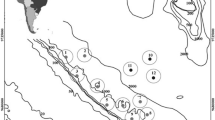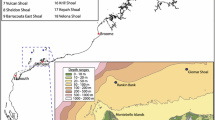Abstract
Due to an increasing emphasis for fish population survey and regulation, efficient tools for evaluating the abundance and diversity of fish from various life stages are needed, especially for coral reef species that present a high taxonomic diversity. The characteristics of six different techniques used for sampling pelagic larvae (a plankton-net and two light-traps), newly settled juveniles (one type of artificial reef), and older juveniles (an underwater seine net in seagrass and macroalgal beds, and rotenone poisoning in coral patches) are described in this study. Larvae belonging to 70 families and juveniles belonging to 34 families were collected. An analysis of similarity (ANOSIM) showed that the taxonomic composition of assemblages collected with the plankton-net and the two light-traps were overlapping but clearly different, due to the higher occurrence of Gobiidae in the plankton-net and of Pomacentridae in both light-traps. Larvae being 2–4 mm standard length (SL) dominated in the plankton-net, whereas larvae being 9–11 mm SL dominated in both light-traps. Pomacentridae juveniles were more abundant in rotenone samples, whereas Labridae dominated in the underwater seine. Juvenile fish collected with the artificial reefs, the underwater seine, and rotenone poisoning largely overlapped in size, with mean sizes of 22, 38, and 33 mm SL, respectively. Seven families were caught by the six sampling techniques, but with unequal success. This study provides ecologists and managers with a unique review of six techniques for sampling a wide range of developmental stages of young fish in different habitats of a coral reef lagoon.


Similar content being viewed by others
Notes
For details on the procedure, see http://www.ecocean.fr.
References
Ackerman JL, Bellwood DR (2000) Reef fish assemblages: a re-evaluation using enclosed rotenone stations. Mar Ecol Prog Ser 206:227–237. doi:10.3354/meps206227
Ackerman JL, Bellwood DR (2002) Comparative efficiency of clove oil and rotenone for sampling tropical reef fish assemblages. J Fish Biol 60:893–901. doi:10.1111/j.1095-8649.2002.tb02416.x
Allen DM, Service SK, Ogburn-Matthews MV (1992) Factors influencing the collection efficiency of estuarine fishes. Trans Am Fish Soc 121:234–244. doi:10.1577/1548-8659(1992)121<0234:FITCEO>2.3.CO;2
Anderson TW, Bartels CT, Hixon MA, Bartels E, Carr MH, Shenker JM (2002) Current velocity and catch efficiency in sampling settlement-stage larvae of coral-reef fishes. Fish Bull (Wash DC) 100:404–413
Barkley RA (1972) Selectivity of towed-net samplers. Fish Bull (Wash DC) 70:799–820
Bellwood DR, Choat JH (1989) A description of the juvenile phase colour patterns of 24 parrotfish species (family Scaridae) from the Great Barrier Reef, Australia. Rec Aust Mus 41:1–41
Boehlert GW (1996) Larval dispersal and survival in tropical reef fishes. In: Polunin NVC, Roberts CM (eds) Reef fisheries. Chapman & Hall, London, pp 61–84
Booth DJ, Brosnan DM (1995) The role of recruitment dynamics in rocky shore and coral reef fish communities. Adv Ecol Res 26:309–385. doi:10.1016/S0065-2504(08)60068-9
Brogan MW (1994) Two methods of sampling fish larvae over reefs: a comparison from the Gulf of California. Mar Biol (Berl) 118:33–44. doi:10.1007/BF00699217
Carassou L, Ponton D (2007) Spatio-temporal structure of pelagic larval and juvenile fish assemblages in coastal areas of New Caledonia, southwest Pacific. Mar Biol (Berl) 150:697–711. doi:10.1007/s00227-006-0389-y
Chapman MG, Clynick BG (2006) Experiments testing the use of waste material in estuaries as habitat for subtidal organisms. J Exp Mar Biol Ecol 338:164–178. doi:10.1016/j.jembe.2006.06.018
Choat JH, Doherty PJ, Kerrigan BA, Leis JM (1993) A comparison of towed nets, purse seine, and light-aggregation devices for sampling larvae and pelagic juveniles of coral reef fishes. Fish Bull (Wash DC) 91:195–209
Clarke KR (1993) Non-parametric multivariate analyses of changes in community structure. Aust J Ecol 18:117–143. doi:10.1111/j.1442-9993.1993.tb00438.x
Clarke KR, Gorley RN (2001) PRIMERv5: user manual/tutorial. PRIMER-E Ltd., Plymouth Marine Laboratory, Plymouth
Cowen RK, Gawarkiewicz G, Pineda J, Thorrold SR, Werner FE (2007) Population connectivity in marine systems, an overview. Oceanography (Wash DC) 20(3):14–21
Doherty PJ (1987) Light-traps: selective but useful devices for quantifying the distributions and abundances of larval fishes. Bull Mar Sci 41:423–431
Doherty PJ (2002) Variable replenishment and the dynamics of reef fish populations. In: Sale PF (ed) Coral reef fishes: dynamics and diversity in a complex ecosystem. Academic Press, San Diego, pp 327–355
Doherty PJ, Williams DMB (1998) The replenishment of coral reef fish populations. Oceanogr Mar Biol Annu Rev 26:487–551
Doherty PJ, Dufour V, Galzin R, Hixon MA, Meekan MG, Planes S (2004) High mortality during settlement is a population bottleneck for a tropical surgeonfish. Ecology 85:2422–2428. doi:10.1890/04-0366
Fisher R, Bellwood DR (2002a) The influence of swimming speed on sustained swimming performance of late-stage reef fish larvae. Mar Biol (Berl) 140:801–807. doi:10.1007/s00227-001-0758-5
Fisher R, Bellwood DR (2002b) A light trap design for stratum-specific sampling of reef fish larvae. J Exp Mar Biol Ecol 269:27–37. doi:10.1016/S0022-0981(01)00384-7
Fuiman LA, Werner RG (eds) (2002) Fishery science, the unique contribution of early life stages. Blackwell, Oxford
Hair CA, Doherty PJ, Bell JD, Lam M (2000) Capture and culture of pre-settlement coral reef fishes in Solomon Islands. In: Proceedings of the 9th International Coral Reef Symposium, Bali, Indonesia, October 2000, vol 2, pp 819–827
Hickford MJH, Schiel DR (1999) Evaluation of the performance of light traps for sampling fish larvae in inshore temperate waters. Mar Ecol Prog Ser 186:293–302. doi:10.3354/meps186293
Hsieh C-H, Reiss CS, Hunter JR, Beddington JR, May RM, Sugihara G (2006) Fishing elevates variability in the abundance of exploited species. Nature 443:859–862. doi:10.1038/nature05232
Hughes TP, Baird AH, Bellwood DR, Card M, Connolly SR, Folke C et al (2003) Climate change, human impacts, and the resilience of coral reefs. Science 301:929–933. doi:10.1126/science.1085046
Lecaillon G, Lourié SM (2007) Current status of marine post-larval collection: existing tools, initial results, market opportunities and prospects. SPC Live Reef Fish Inf Bul 17:3–10
Leis JM (1991) The pelagic phase of coral reef fishes: the larval biology of coral reef fishes. In: Sale PF (ed) The ecology of fishes on coral reefs. Academic Press, San Diego, pp 183–230
Leis JM, Carson-Ewart BM (eds) (2000a) The larvae of Indo-Pacific coastal fishes, an identification guide to marine fish larvae. Fauna Melanesia handbook, vol 2. Australian Museum, Sydney
Leis JM, Carson-Ewart BM (2000b) Behaviour of pelagic larvae of four coral-reef fish species in the ocean and an atoll lagoon. Coral Reefs 19:247–257
Leis JM, McCormick MI (2002) The biology, behavior, and ecology of the pelagic, larval stage of coral reef fishes. In: Sale PF (ed) Coral reef fishes: dynamics and diversity in a complex ecosystem. Academic Press, San Diego, pp 171–200
Leis JM, Trnski T (eds) (1989) The larvae of Indo-Pacific shorefishes. New South Wales University Press, Kensington
Leis JM, Carson-Ewart BM, Webley J (2002) Settlement behaviour of coral-reef fish larvae at subsurface artificial-reef moorings. Mar Freshw Res 53:319–327. doi:10.1071/MF01082
Lindquist DC, Shaw RF (2005) Effects of current speed and turbidity on stationary light-trap catches of larval and juvenile fishes. Fish Bull (Wash DC) 103:438–444
McIlwain JL (2003) Fine-scale temporal and spatial patterns of larval supply to a fringing reef in Western Australia. Mar Ecol Prog Ser 252:207–222. doi:10.3354/meps252207
Mellin C (2007) Sélection de l’habitat à l’installation et utilisation de l’habitat post-installation chez les poisons récifaux-lagonaires de Nouvelle-Calédonie. PhD dissertation, Université de Paris VI, Paris, France
Milicich MJ, Meekan MG, Doherty PJ (1992) Larval supply: a good predictor of recruitment of three species of reef fishes (Pomacentridae). Mar Ecol Prog Ser 86:153–166. doi:10.3354/meps086153
Morse WW (1989) Catchability, growth, and mortality of larval fishes. Fish Bull (Wash DC) 87:417–446
Moser HG (1981) Morphological and functional aspects of marine fish larvae. In: Lasker R (ed) Marine fish larvae: morphology, ecology and relation to fisheries. University of Washington Press, Seattle, pp 89–131
Murphy GI, Clutter RI (1972) Sampling anchovy larvae with a plankton purse seine. Fish Bull (Wash DC) 70:789–798
Murphy BR, Willis DW (eds) (1996) Fisheries techniques, 2nd edn. American Fisheries Society, Bethesda
Randall JE (2005) Reef and shore fishes of the South Pacific: New Caledonia to Tahiti and the Pitcairn Islands. University of Hawaii Press, Honolulu
Sale PF (ed) (2002) Coral reef fishes: dynamics and diversity in a complex ecosystem. Academic Press, San Diego
Smith KA, Sinerchia M (2004) Timing of recruitment events, residence periods and post-settlement growth of juvenile fish in a seagrass nursery area, south-eastern Australia. Environ Biol Fishes 71:73–84. doi:10.1023/B:EBFI.0000043154.96933.de
Strydom N (2007) Jetski-based plankton towing as a new method of sampling larval fishes in shallow marine habitats. Environ Biol Fishes 78:299–306. doi:10.1007/s10641-006-9097-1
Suthers IM, Frank KT (1989) Inter-annual distributions of larval and pelagic juvenile cod (Gadus morhua) in southwestern Nova Scotia determined with two different gear types. Can J Fish Aquat Sci 46:591–602
Thorrold SR (1992) Evaluating the performance of light traps for sampling small fish and squid in open waters of the Central Great Barrier Reef lagoon. Mar Ecol Prog Ser 89:277–285. doi:10.3354/meps089277
Valles H, Kramer DL, Hunte W (2006) A standard unit for monitoring recruitment of fishes to coral reef rubble. J Exp Mar Biol Ecol 336:171–183. doi:10.1016/j.jembe.2006.05.005
Wilson GG (1998) A description of the early juvenile colour patterns of eleven Lethrinus species (Pisces: Lethrinidae) from the Great Barrier Reef, Australia. Rec Aust Mus 50:55–83
Acknowledgments
We are most grateful to J. Baly and G. Mou-Tham for modifying the Aquafish light-traps, and the field and laboratory work. We also thank the different captains of the NO Coris and Aldric: M. Clarque, N. Colombani, and S. Tereua. A.M. Lassallette (University of the French West Indies, Martinique) helped in the editing of the English text. Thanks go to the two anonymous reviewers for their comments and detailed suggestions.
Author information
Authors and Affiliations
Corresponding author
Rights and permissions
About this article
Cite this article
Carassou, L., Mellin, C. & Ponton, D. Assessing the diversity and abundances of larvae and juveniles of coral reef fish: a synthesis of six sampling techniques. Biodivers Conserv 18, 355–371 (2009). https://doi.org/10.1007/s10531-008-9492-3
Received:
Accepted:
Published:
Issue Date:
DOI: https://doi.org/10.1007/s10531-008-9492-3




